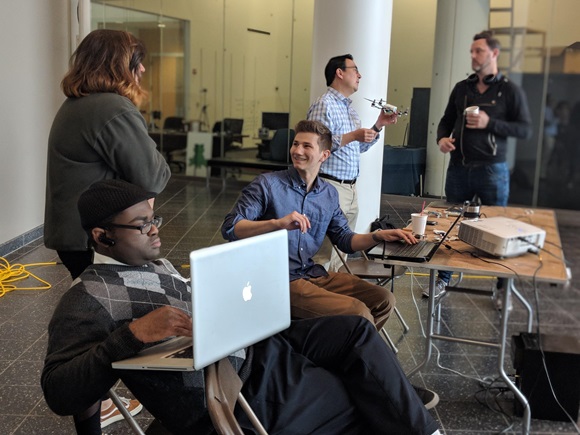Arts Capacitor: Drone Workshop
Building Engagement Through Transdisciplinary Collaboration
May 18, 2018

On May 12th, members of The ExCITe Center’s Music and Entertainment Technology Lab joined a group of artists for the inaugural Arts Capacitor event. Emre Fisher, ExCITe’s Creative Technologist Co-op, has been optimizing a system that makes drone technology more accessible and affordable. The workshop included live demonstrations, hands-on experimentation, and interdisciplinary collaboration between local artists and the technologists here at ExCITe.
We first began to develop indoor drone-flight technology in 2014 in collaboration with Parsons Dance. Building a system that allowed for multiple drones to be autonomously controlled in an indoor space was difficult, but we recognized that the technology had the potential to benefit a significantly larger audience.
Read more at the MET-lab website
Over the past six months, the indoor drone flight system has been rethought to broaden access for potential use by other artists. Expensive motion-capture cameras were replaced by more affordable radio nodes; the custom drones designed for Parsons Dance were replaced by commercially available, relatively low-cost micro-drones. Emre Fisher, ExCITe’s Creative Technologist Co-op and a third-year Computer Engineering student at Drexel University, has worked to design a system that more artists can afford and use. “With this project, we were trying to make a lower-budget aerial choreography system...where a general artist could invest in this system for around a thousand dollars and be ready to showcase their work.”
The intimate scale of the workshop allowed for one-on-one guidance from members of MET-lab. Dr. Youngmoo Kim opened the event with an introduction to the technology and a live demonstration of the micro-drones. From there, the participants were instructed to design their own flight paths. The first couple of attempts were fairly simple - the drones followed a basic path, with little variance or complex design. This was as expected: we anticipated that many of the attendees would be coming into the workshop without any sort of technical background. The interface we developed to create the flight-paths was optimized so that anyone, regardless of prior experience, could understand and explore the capability of the drones.
"It was fun seeing artists push the limitations of the system."
After a few successful flights, confidence began to build and the artists began incorporating more complex elements to their attempts. We spoke to the participants to understand why the workshop drew their attention and how they’d like to utilize this technology. “I work at the Franklin Institute”, Stephanie, a student at the Moore College of Art & Design said, “and I definitely see the benefits of system like this.” Stephanie envisioned an educational program that uses drones to depict constellations. The drones could move as unit, demonstrating how our planet affects the positioning of the stars throughout the year. She also envisions the drones hovering at different heights, demonstrating the spatial distance between the stars compared to the limited perspective we get with the naked eye.
“I'd like to utilize drones as lighting elements in a show,” said Kevin, a stage technician based outside of Philadelphia. “I think they have potential as a mobile, programmable, lighting rig.”
One participant, Charles, already uses drones for his profession. He’s a photographer and visual artist, and he takes his drones all around the city to create panoramic, aerial shots of famous landmarks. This was the first time he’s ever used drones indoors, however. In fact, it was the first time he’s ever flown a drone without using a controller. “It’s a completely different system,” he said. “I’ve never tried to do something like this before - but now I might.”
The workshop did have its fair share of missteps. In a couple flights, the drones veered off their paths or careened into walls. In other cases, the drones wouldn’t take off at all. Despite these hiccups, we believe the workshop was an overall success. “You don’t bring artists in to see a finished product,” says Kara Lindstrom, Program Director for the ExCITe Center.
"The future is optimistic for drones and new technologies in the arts."
As much as this workshop was meant to build capacity in the arts, it was also an opportunity for our technologists to get feedback on a project still in a developmental stage. Emre Fisher noted how valuable it was to see artists engage with this technology directly. “It was fun seeing the artists push the limitations of the system. Every time an artist came up to me with their choreography I could tell they were excited to see the fruits of their labor.”